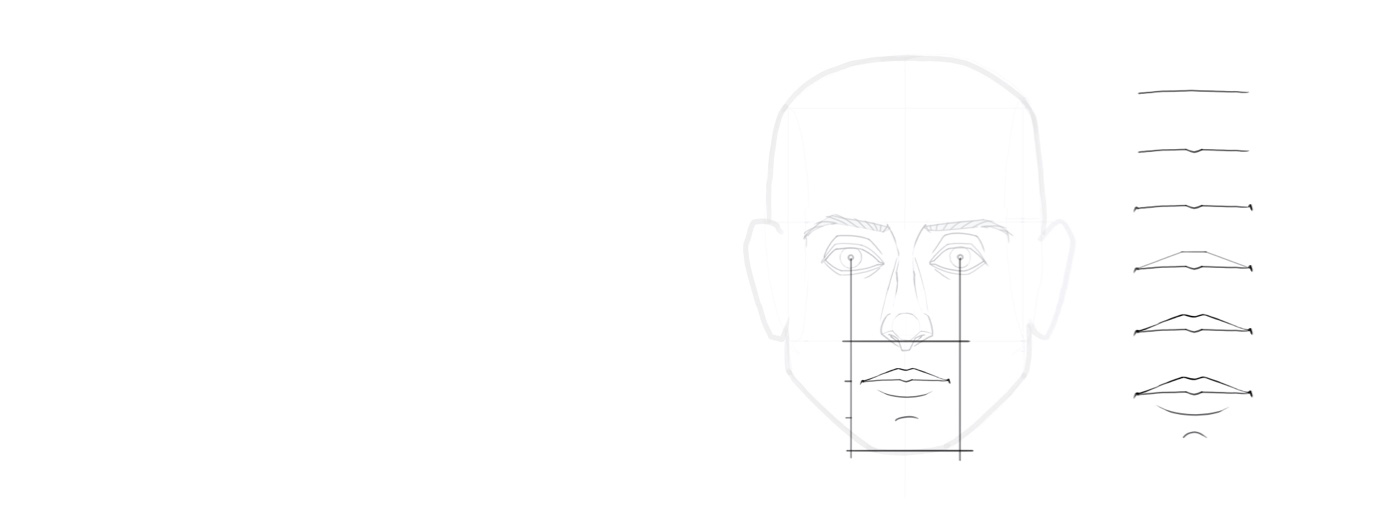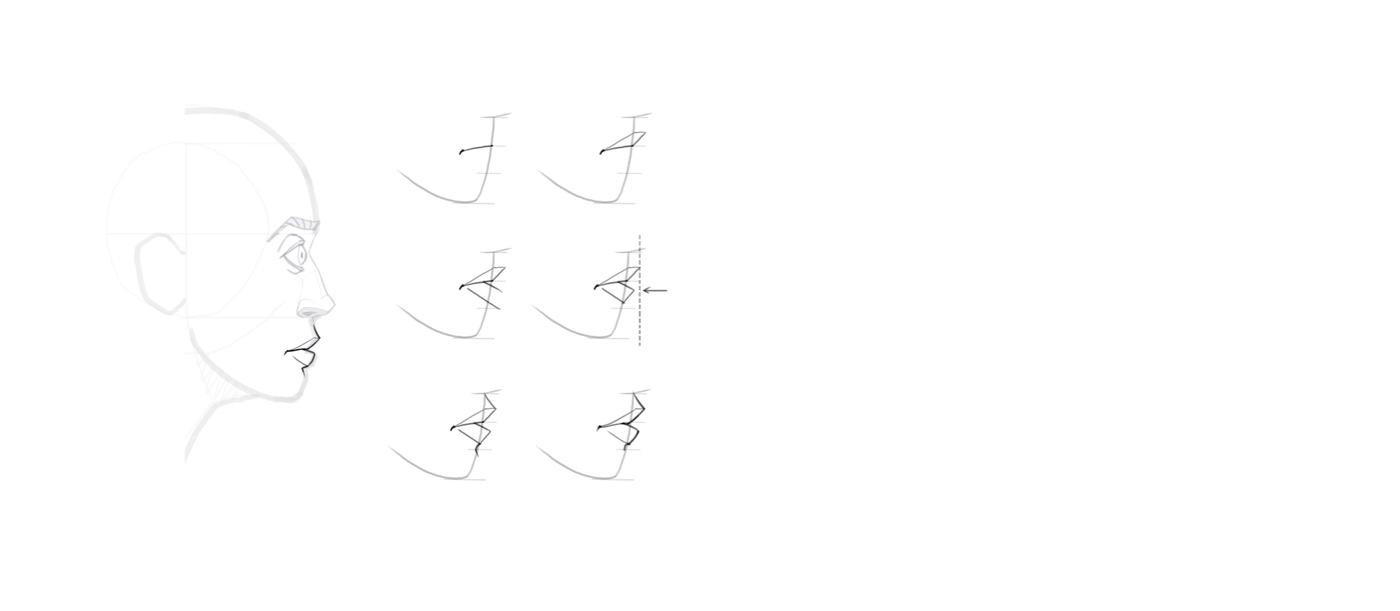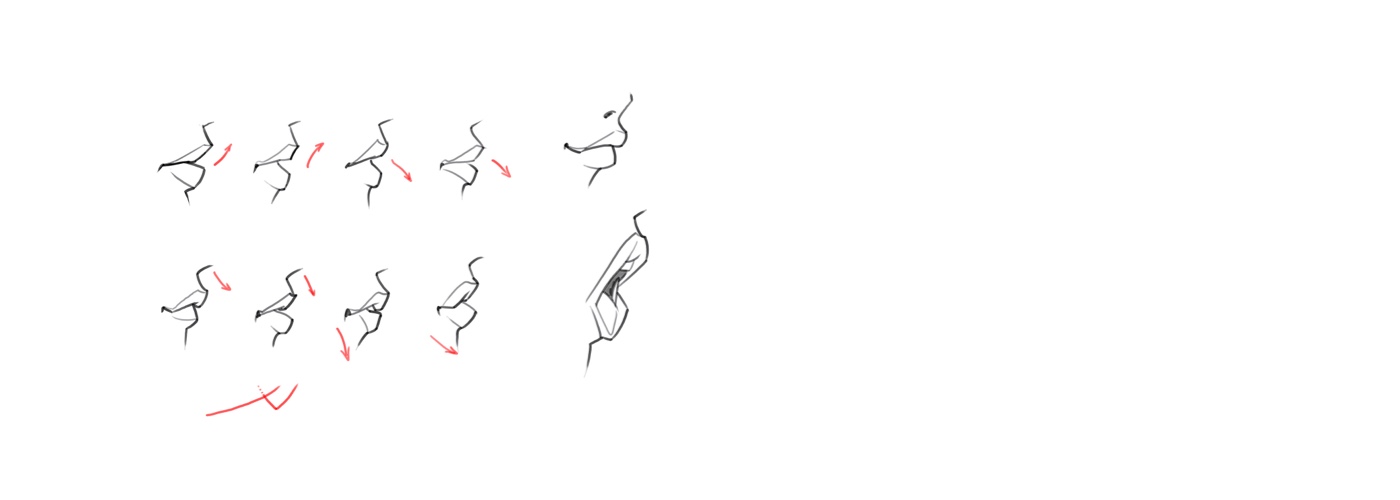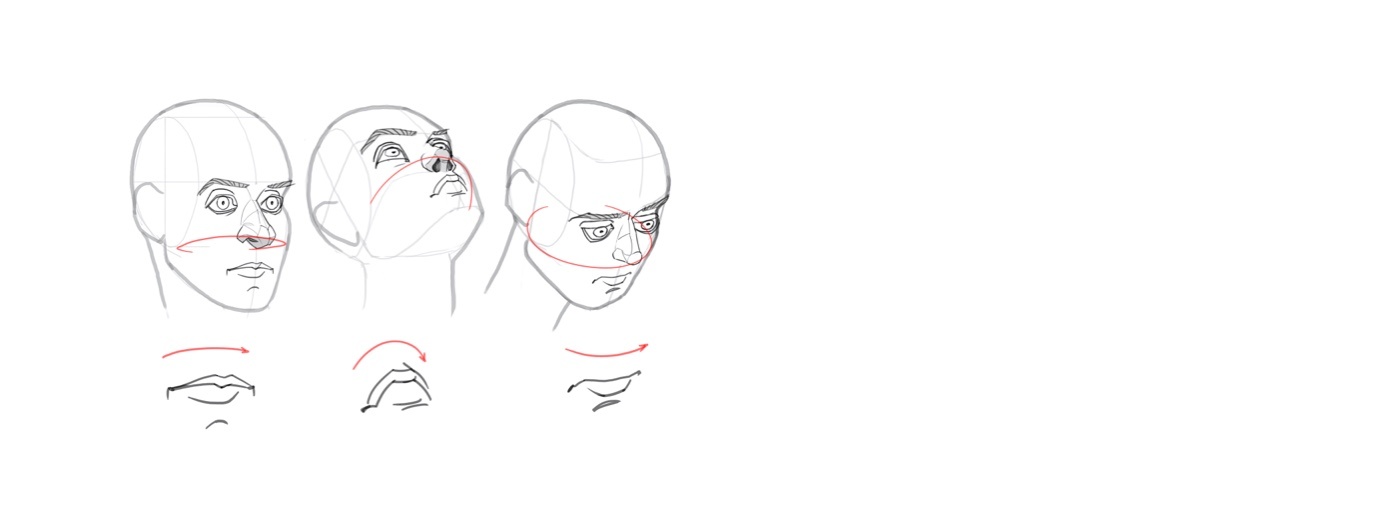


Wacom 大家庭,大家好!
人臉絕對是讓眾多藝術家最費盡心思的題材。這就是為何我們認為,逐一仔細觀察臉部的各個部分是個好主意。今天我們要來討論怎麼畫嘴巴。
與眼睛、鼻子相比,嘴巴是種類要多得多的臉部特徵。不同繪師畫眼睛、鼻子的手法往往可以非常相似,但處理嘴巴的時候會有比較多發揮創意的機會。而且,從解剖學來說,嘴巴是最靈活的臉部特徵,所以可以呈現出各種各樣的形狀。只用一個短短的教學,根本不可能深入探討人類嘴巴可以表達出的各種心理狀態。本教學會介紹下顎及周圍相應肌肉組織的解剖結構,這些肌肉組織依嘴巴位置不同會有很大差異。至於完整說明繪製嘴巴的不同風格選擇,則不在這次教學的範圍內。
所以,我在第一張圖中選擇使用不同風格和位置的橫切面。在這次如何繪製嘴巴的教學中,我們會集中討論首選畫法。當然,我們並不想用這種畫法侷限大家的畫風。一如往常,我們的主要目的是找出一個盡量能夠啟發各位的概念。
我們開始吧!

Let's begin with the position of the mouth. After we have constructed the head, the guide lines will give us the vertical position. The mouth lies on the first subdividing line between nose and chin. This means the distance from mouth to chin should be about twice the distance from mouth to nose. The width of the average mouth is at most as wide as the distance between the pupils. Experience shows that we should reduce this width a bit.
To start to answer the question about how to draw a mouth, we draw a simple line. This is the main line of the mouth: the lower edge of the upper lip. Starting with this line is the quickest, most intuitive way to define a mouth’s shape. The line doesn't have to be perfectly straight, but you should try and save more adventurous curves for later.
接下來,我們在這條線的中點加上下唇的「V」。這個可以非常明顯,也可以根本不存在。剛開始,我們先把自己限制在一個非常微妙的「V」好了。確保「V」線條不是直線,而是稍微向下彎曲。
兩個外緣我們都各加一個弧形:嘴角。這兩個弧形會在很大程度上最終決定嘴巴的整體表情。
繪製上唇時,為了確保能盡量對稱,最好先建構出一個扁平的梯形。
現在我們利用這個梯形結構,盡量優雅地繪製上唇的輪廓。輪廓應該要從兩側輕輕升起,然後在中間形成一個小小的「V」形凹痕。你會發現畫這條線的困難點在於,必須確保線條不會太圓也不會太有稜有角。
最後,下唇是簡單的扁平「U」形。這個「U」應該指向兩個嘴角,不過在多數情況下,最好不要把嘴角跟下唇連起來。
另一個倒「U」用來表示下巴。這個下巴「U」現在正好位於兩條頭型結構引導線的下方。

這裡你會看到同一張嘴有著三種不同的嘴角。嘴角可以畫得向上或向下,可以厚或薄,甚至可以嘗試更誇張的形狀。大家要記住,這些不起眼的小弧形的微小變化,會大大影響你們畫出來的臉部表情。這不是最明顯的線條,但是大約有 90% 的臉部情緒,不管是快樂、悲傷或是其他情緒,都會由這些小線條來決定。如果你畫的臉沒有達到自己想要的表情,原因通常是嘴角!

考慮要畫嘴巴的時候會發現,上唇的形狀可能會因為臉而有很大差異。狹窄的上唇通常看起來會比較陽剛。扁平的「V」形凹痕,可以讓上唇看起來比較有女人味一些。但這當然不是説,女性的嘴唇就一定比男性寬。這絕不是不變的規則。

下方的「V」也可以透過不同的形狀呈現。可以畫得比較明顯或是不明顯,或是畫成半圓形。
最後,下唇也可以畫得不像「U」形,例如,向中間變平或略微上揚(見最後一張圖)。
知道的變化愈多,繪製不同嘴巴時的選擇可能性和想法就會愈豐富。
接下來,我們把嘴巴張開。這裡有好幾件事情需要注意。

嘴巴張得愈寬,整體的寬度和嘴唇就會顯得愈窄。如果嘴巴張得很大,嘴唇就會被拉長,因而變薄。上唇的兩個「V」也會跟著變平。
如果略過齒縫不畫的話,牙齒其實是最容易呈現的。把齒排約略畫成連續表面很有幫助,因為在牙齒之間繪製空間可能會讓人覺得牙齒之間有縫隙。如果你還是想逐個呈現牙齒,那麼請盡量精細地繪製齒縫。
一般來說,只有在嘴巴張得非常大的時候,我們才能看到下排牙齒。你在這邊還可以暗示上顎和舌頭,但用連續的黑色表面來表示嘴巴內部通常就夠了。所以,我們還是把注意力放在如何繪製嘴巴上,而不要過多介紹嘴巴內部的細節。

一樣先從主線條開始:上唇下緣,包括嘴角處的弧形。這裡要注意,主線條是朝下的。乍看之下可能會覺得這個嘴巴很悲傷,但別被迷惑了,嘴角才是決定心情的關鍵。
如圖所示,剖面圖中的上唇會呈現向前急劇傾斜的梯形,而且明顯突出於頭型。
下唇應該要有與上唇重疊的大致矩形形狀。最好從兩條幾乎平行且朝下的線開始。第一條從嘴角開始。第二條則從上唇內側開始。如圖所示,這條線會從上唇嘴角的左側開始。
現在我們來完成下唇的矩形。這裡請注意,比起上唇,下唇從臉部突出的幅度比較小。
最後,把上下嘴唇與鼻子和下巴連起來。

這種建立結構的方法往往能提供很大的自由度。你可以自己決定使用什麼比例、線條想要彎到哪個角度、邊緣想要有多尖銳或多柔軟,以及個別線條該向內彎或向外彎,或是呈現「S」形。幾乎一切都有可能。
當然,你也可以加入兩個「V」。不過畫剖面時,務必確保左側主線與下方底線上的「V」重疊。

請始終從主線條出發,因為這裡是其餘結構的基礎。主線條會順著頭部的曲線走。如果頭部向上傾斜,主線條就會變成向上的曲線。如果頭部向下傾斜,主線條曲線也會跟著指向下方。
除此之外,不管頭部朝上或朝下,我們都必須考慮嘴唇的視角也會跟著發生變化:不同視角的嘴唇,某些區域看起來會比較窄或比較寬。如果我們把頭往下轉得夠遠,嘴唇就會完全消失。轉頭時,下唇與下巴線的距離也會因此縮短。

現在我們來幫嘴唇加上陰影。正面的嘴巴很適合加陰影。如果是以數位方式繪圖,最好另開圖層來進行下列步驟。
首先,我們用中灰色調填滿整個唇部區域。
仔細思考怎麼繪製嘴巴時會發現,嘴唇上的多數陰影都是沿著主線條產生的。陰影應該要比背景層再稍微暗一些,但不要暗到蓋住輪廓。陰影區域應分別跟隨主線條上方和下方的唇形。底部會略呈「U」形,頂部則是常見的「V」形。

現在我們來劃定兩個最亮的區域。這兩個區域位於上唇頂部,以及下唇呈豆狀的水滴狀陰影正下方。嘴唇往往會有一點光澤,所以明亮的區域可以簡單用硬邊畫成白色。
最後,為了加點肌膚紋理,可以在某些地方打斷兩個白色區域。最簡單的方法是用橡皮擦在白色區域的平面,快速做出一些條紋。這樣做的時候,務必要從中心線向上和向下放射狀延伸。可以想像成杏仁形太陽的光線。
只要稍加練習,就會發現這種有點抽象但大膽的陰影技法效果很好,不同的視角也很容易運用。雖然如此,我們還是繼續來嘗試細節更加豐富的版本。

嘴唇上佈滿非常細緻的垂直皺紋。如第一張圖片所示,這些可以在嘴唇畫上許多略微向外彎曲的細筆觸嘴唇來呈現。最好只選用大約 30% 的不透明度,然後盡量快速勾勒出筆觸,類似於畫影線的技法。如果影線超出唇緣也沒關係,因為你可以之後再輕鬆擦除所有超出在外的影線。畫的時候,從左邊緣開始,向內移動至中心。抵達中心點時,旋轉工作檯面。這一招是改變曲線方向最簡單的方法。
現在另開圖層重複相同的流程,不過這次使用白色。

將主線條分成許多重疊的「U」,是另一種想要呈現更多細節的技法。試著盡量變化多一點:寬「U」、窄「U」、高「U」和平「U」。但兩端一定要向上變細。「U」的斜面朝兩側變平,反映出細的紋理線條。而且也務必將「U」的下緣放在主線條上。

為了讓大家理解得更清楚,我在這裡重點強調各個步驟中使用的圖層,並且隱藏了部分不必要的圖層。在第一張圖,你可以看到目前為止所有組成部分的效果,包括灰色背景區域。每一步都在各自的圖層。這讓我們可以靈活地進行最後的潤飾:
首先,我們可以降低各圖層的不透明度,以便順利地將圖層合而為一(圖 2)。含有許多白色和黑色細小結構線的圖層可能會做得比較不顯眼一點,所以最好稍微調低這些圖層的不透明度。
第三張圖顯示了部分的細微修改。少數幾個地方的結構似乎畫得有些誇張。我們可以用軟橡皮擦小心擦掉這些區塊。在圖片中,我已經擦掉沿著上唇上緣的黑色結構,只在下唇留下白色紋理的豆狀區域。
此外,嘴唇的外緣看起來還是有點太硬。所以我們可以軟化一下灰色背景區域的邊緣。

現在我們運用陰影來賦予嘴唇更多的深度,類似之前抽象的嘴巴,不過這次邊緣比較柔和一點。我們需要主線條正下方顏色最深的陰影。這裡的陰影色調可以很深,幾乎是黑色。
我們再次劃定兩個明亮區域:一個位於上唇頂部,另一個位於下唇陰影下方的杏仁形區域。你不一定要完全按照我的形狀來劃定,試著想像嘴唇哪些地方最亮就可以了。

最後,我們可以加上與抽象版本相同的光澤圖層,然後稍微編輯調整一下。如你所見,我稍微突顯了一下上方的「V」。
當然,不是每張嘴巴都必須像上一個例子那樣詳細畫出來。但是,細節多少當然沒有限制。你可以自己決定作品適合哪種細節程度。
希望你在這次學習如何畫嘴巴的過程中畫得很開心,也希望本教學能讓你學到一兩個對今後繪畫有用的技巧。
下次見。
受惠於 13.3 吋螢幕自然的表面摩擦和極低的反光,Wacom One 能創造出熟悉的、紙筆般真實的書寫體驗。數位筆手感輕盈自然,其可在你選擇的軟體中化身為鉛筆、筆刷或粉筆,為你提供繪製嘴巴所需的一切。裝置隨附創作用軟體,並可將其連接至你的電腦以及特定 Android 裝置。

Wacom One 13 手寫液晶顯示器
以精準的數位筆在高解析度螢幕上進行直覺式繪圖、設計和創作。
透過自然的介面技術讓人與科技緊密相依,是 Wacom 一貫的願景。這項願景讓 Wacom 成長為全球的互動式數位板、手寫液晶顯示器及數位筆的龍頭製造商,更是數位簽章保存與處理解決方案供應商。Wacom 直覺式輸入裝置的先進技術,已在全球各地造就出許多一流數位藝術、電影、特效、時尚及設計鉅作,其領先的介面技術同時為商業和家庭用戶提供表達自我個性的利器。創立於 1983 年的 Wacom 是全球性企業,總部位於日本(東京證券交易所股號:6727),分公司及行銷與銷售代表處遍佈世界各地 150 多個國家。